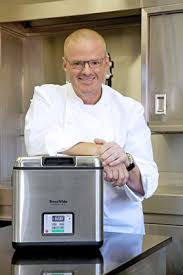Professor Hugh Pennington provides a fifty-year historical perspective on food safety to mark the Institute of Food Science and Technology’s Jubilee. Edited comments below:
IFST formally adopted its constitution on 13 May 1964. By pure coincidence, on the same date the first victim of the Aberdeen typhoid outbreak developed a high fever. Still feared, the evil reputation of the disease had long outlived its impact. The typhoid standard mortality ratio in England and Wales had fallen more than two hundred fold in the first 50 years of the twentieth century, and had then been reduced to almost zero by antibiotics.
Nevertheless, there was much fear in May, June and early July 1964 when 507 Aberdonians contracted the disease. Nobody died from the direct effects of infection, so the outbreak was old-fashioned in terms of its causative microbe, but modern in terms of its effects. This contrast extended to its handling. Casualty figures of sufferers and their names and addresses were published regularly in the local papers as if the Second World War was still in progress, and the end of the outbreak was announced as the ‘All Clear’. However in modern style, the Aberdeen Medical Officer of Health, Dr Ian MacQueen, gave daily press conferences and appeared nightly on television (although his approach was old-fashioned in that he had a pipe which he rapped on his desk, turning and pointing it towards reporters who asked awkward questions). Unfortunately, his microbiological knowledge was wanting. The main thoroughfare in town, Union Street, was sprayed with disinfectant. The University sent a note to external examiners ‘There is a remote risk of infection through perspiration on examination scripts. Examiners who wish to take precaution on this score should wear cotton gloves’. MacQueen’s pronouncements led to Aberdeen being dubbed the ‘Beleaguered City’. A royal visit was deemed necessary to start rehabilitation; Her Majesty came on 28 June.
 The cause of the outbreak was Salmonella Typhi contained in a can of improperly manufactured corned beef imported from Argentina. It had been sold sliced in a small, new supermarket in Aberdeen between 6 and 9 May, infecting about 50 people, many of them young women living in the prosperous west end of the town, who had consumed it as part of a slimming diet. The slicing machine became contaminated and transferred the organism to other cold meats, the consumption of which caused the other 450 cases and prompted the joke ‘that only in Aberdeen would you get 500 slices out of a can of corned beef’. The first patient to be discharged from hospital, a 23 year-old woman, was presented with a sash proclaiming her ‘Typhoid Queen 1964’. …
The cause of the outbreak was Salmonella Typhi contained in a can of improperly manufactured corned beef imported from Argentina. It had been sold sliced in a small, new supermarket in Aberdeen between 6 and 9 May, infecting about 50 people, many of them young women living in the prosperous west end of the town, who had consumed it as part of a slimming diet. The slicing machine became contaminated and transferred the organism to other cold meats, the consumption of which caused the other 450 cases and prompted the joke ‘that only in Aberdeen would you get 500 slices out of a can of corned beef’. The first patient to be discharged from hospital, a 23 year-old woman, was presented with a sash proclaiming her ‘Typhoid Queen 1964’. …
A raw milk–borne outbreak in 1981 in Keith, in the north-east, was a signal Salmonella event for Scotland because of its regulatory impact. Since 1970 there had been 50 milk-borne Salmonella outbreaks in Scotland affecting more than 3,500 individuals, with 12 deaths. The Keith outbreak affected 650, with 2 deaths. An economic study of this outbreak showed a mid-range cost per patient of £2637. The retail sale of unpasteurised milk was banned from August 1983. Sad to say, there are still individuals in Scotland who campaign to reverse this rational evidence-based policy.
The Salmonella outbreak at Stanley Royd Hospital, a psychogeriatric hospital in Wakefield, started on the August Bank Holiday weekend of 1984. At the time of the outbreak it had 788 resident patients; 355 fell ill and Salmonella Typhimurium was isolated from stools from 218. One hundred and six of the 980 staff had symptoms. Nineteen patients died, the last on the 9th of September. A Public Inquiry was announced on September 14th. It determined that the cause of the outbreak was contaminated cold roast beef served to the patients on the 25th of August. The organism had a poultry source and almost certainly had come from chicken carcases that had been defrosted.
As a horror story the Inquiry Report is hard to beat. The hospital kitchens had been constructed in 1865. Their open drainage channels had resident cockroaches which were attractive scapegoats for the source of the infection. However, FOOD & MICROBES they were an oriental kind which could not climb and they were negative for Salmonella. On the other hand, the rat that was killed in the kitchen on the 11th October was infected with the outbreak strain. But the Inquiry concluded that ‘the condition of this creature was more likely to have been a consequence than a cause of the outbreak’. It was a victim. Attempts had been going on for years to upgrade or replace the kitchens, but nothing had been done. The Inquiry concluded that this was ‘a remarkable example of what well intentioned individuals can fail to achieve unless someone is charged with the responsibility of ensuring that careful attention to detail does not lead to a complete cessation of all activity other than the production of paper’. There had been paralysis by analysis.
Salmonella Typhimurium struck again in North Wales and Cheshire in 1989. Six hundred and forty were affected, half on each side of the border. Seventy-four were hospitalised and three died. As in Aberdeen, sliced meats were the culprit, but in this case the pork and ham cross-contaminated the tinned corned beef cut on the same machine. …
In the early 1980s the Salmonella situation began to change with the rise of Salmonella Enteritidis, in particular phage type 4. In England and Wales in 1982, 413 isolations were made from humans, accounting for 3% of all such non-typhoidal Salmonellas. The numbers increased steadily, reaching a peak in 1993 with 17,257 isolations, accounting for 56% of all non-typhoidal Salmonellas. In 1988 (12,522 Enteritidis isolations) matters had already come to a head when the Chief Medical Officer for England instructed hospitals to stop using raw egg in favour of pasteurised products. Edwina Currie, Parliamentary Under-Secretary for Health, felt it was time to act and in early December she said on Independent Television News ‘most of the egg production in this country, sadly, is now infected with Salmonella’. She didn’t say ‘don’t eat eggs’, but nevertheless egg consumption fell. She said later ‘both MAFF and the producers took a dim view of my action; they regarded me as the problem, and that if I were removed the issue would go away. I was informed that writs had been served and I resigned from office on 16 December. Subsequently I discovered that there were no writs’. At this point Kenneth Clarke, the Minister of Health, persuaded Margaret Thatcher to set up a Cabinet Committee on food safety (MISC 138); its work led to the 1990 Food Safety Act. Salmonella Enteritidis is now a shadow of its former self. Specific targeting by vaccinating poultry has worked well. It still outnumbers Salmonella Typhimurium, but only just. In 2012 there were 2169 isolations reported from humans in England and Wales.
 Two other food borne diseases took off in the 1980s. Control measures to date for neither Campylobacter nor E.coli O157 can be considered a success. The 1975 edition of the bacteriologist’s bible, ‘Topley and Wilson’s Principles of Bacteriology, Virology and Immunity’, mentions Campylobacter only as a rare medical curiosity, ‘as occasionally causing disease in man, mostly in patients already debilitated by some other illness’. It does not describe it as a cause of infectious intestinal disease. But by 1981, with 12,168 laboratory diagnosed cases, it had overtaken Salmonella in England and Wales in this regard. Laboratory methods for its routine identification only became available in 1977, and it is reasonable to suppose that this explains much of the increase shown by the early statistics. Campylobacter has received much less media attention than it probably deserves. This is because it hardly ever causes dramatic outbreaks and journalists find its name hard to spell. Attempts to establish the precise routes of transmission have been greatly impeded by the sporadic nature of the overwhelming majority of cases and the difficulty in fingerprinting strains coupled with their significant genetic diversity. This diversity also indicates that control by vaccination is unlikely to be effective. Studies on chicken carcases and recent work using modern genotyping methods have shown that poultry meat is the most important source. Milk-borne outbreaks have also shown the importance of cattle as a source. Campylobacter control was a top priority for the Food Standards Agency from its inception in 2000, when 58,236 laboratory diagnoses were reported in England and Wales. In that year it published a ground breaking Report of the Study of Infectious Intestinal Disease (IID) in England, which demonstrated the true scale of the problem in its conclusion ‘for every 136 cases of IID in the community, 23 presented to a GP, 6.2 had a stool sent routinely for microbiological examination, 1.4 had a positive result, and one was reported to the PHLS’ CDSC.’ There was early optimism that a focus on improved hen house hygiene was bearing fruit. The number of laboratory reports of human infections fell to 44,577 in 2004. But the optimism was misplaced; the figures have since risen steadily, reaching 65,032 in 2012.
Two other food borne diseases took off in the 1980s. Control measures to date for neither Campylobacter nor E.coli O157 can be considered a success. The 1975 edition of the bacteriologist’s bible, ‘Topley and Wilson’s Principles of Bacteriology, Virology and Immunity’, mentions Campylobacter only as a rare medical curiosity, ‘as occasionally causing disease in man, mostly in patients already debilitated by some other illness’. It does not describe it as a cause of infectious intestinal disease. But by 1981, with 12,168 laboratory diagnosed cases, it had overtaken Salmonella in England and Wales in this regard. Laboratory methods for its routine identification only became available in 1977, and it is reasonable to suppose that this explains much of the increase shown by the early statistics. Campylobacter has received much less media attention than it probably deserves. This is because it hardly ever causes dramatic outbreaks and journalists find its name hard to spell. Attempts to establish the precise routes of transmission have been greatly impeded by the sporadic nature of the overwhelming majority of cases and the difficulty in fingerprinting strains coupled with their significant genetic diversity. This diversity also indicates that control by vaccination is unlikely to be effective. Studies on chicken carcases and recent work using modern genotyping methods have shown that poultry meat is the most important source. Milk-borne outbreaks have also shown the importance of cattle as a source. Campylobacter control was a top priority for the Food Standards Agency from its inception in 2000, when 58,236 laboratory diagnoses were reported in England and Wales. In that year it published a ground breaking Report of the Study of Infectious Intestinal Disease (IID) in England, which demonstrated the true scale of the problem in its conclusion ‘for every 136 cases of IID in the community, 23 presented to a GP, 6.2 had a stool sent routinely for microbiological examination, 1.4 had a positive result, and one was reported to the PHLS’ CDSC.’ There was early optimism that a focus on improved hen house hygiene was bearing fruit. The number of laboratory reports of human infections fell to 44,577 in 2004. But the optimism was misplaced; the figures have since risen steadily, reaching 65,032 in 2012.
Campylobacter and E.coli O157 are similar in that neither is pathogenic in its usual hosts (ruminants for the latter). But E.coli O157 is different because one can be certain that its emergence as a new pathogen was not just a statistical event caused by the development of a new laboratory test, but was due to evolution in action in real time. The first cases in England occurred in 1983 in Wolverhampton. A retrospective search of E.coli strains collected in previous years showed that it was a new pathogen. Events since have demonstrated its ability to spread from person-to-person; at least 20% of cases in food-borne outbreaks have been amplified in this way and outbreaks in nurseries and childcare establishments occur regularly. The incidence of infection in the UK is only matched internationally by that in Canada. Within the UK, for many years incidence in Scotland has been more than double that in England. In 2012, 795 diagnoses were made in England and 236 in Scotland, which has a population of less than one tenth that of England. Only about 40% of cases in Scotland are food-borne. Infection leads to the haemolytic uraemic syndrome (HUS) in 10-15% of cases. This complication is much more common in children under 5 and in the elderly. Once an infection has been established, it cannot be prevented by any medical measures. About 10% of HUS cases are left with permanent damage, either renal or neurological, and about 4% die. These effects and its propensity to cause outbreaks have made it a focus of attention, rather than the incidence of infection. Two foodborne outbreaks have had regulatory impacts.
The central Scotland outbreak occurred in November and December 1996. Seventeen died directly from infection with the outbreak strain, all elderly, and 503 fell ill. John Barr, a butcher at Wishaw, was responsible. He was prosecuted, pleaded guilty on charges under the Food Safety Act, and was fined £2250. The outbreak strain was isolated from gravy retained from a church lunch (eight died), a vacuum packing machine, and a range of raw and cooked meats. I conducted an inquiry for the Secretary of State for Scotland. In consequence a butchers’ licencing scheme was introduced throughout the UK and £19M was provided to facilitate the acceleration of the implementation of HACCP. Memory of the outbreak coupled with the impact of BSE and vCJD led to the formation of the Food Standards Agency in 2000.
Subsequently, the number of outbreaks of IID associated with butchers fell; there were 5 in 2000, 3 in 2001, none in 2002 and 2003, and one in 2004. But in 2005 a big outbreak occurred in South Wales, affecting 44 schools with 118 laboratory confirmed cases. One 5-year old boy died. William Tudor, the butcher responsible for supplying contaminated cold meats to the schools was prosecuted. He pleaded guilty to six offences of placing unsafe food on the market and one of failing to protect food against the risk of contamination, and was sentenced to 12 months imprisonment. I chaired a Public Inquiry into the outbreak. My report was published in March 2009. Fifteen of its recommendations focused on HACCP and related issues. Unfortunately, many of the deficiencies found at Tudor’s in 2005 were exactly the same as those at Barr’s in 1996. The central problem was the failure to prevent cross-contamination. One example suffices. Working surfaces, implements and machinery at Barr’s were being cleaned with a green liquid. Because it was labelled ‘biodegradable’ his staff thought that it killed bacteria. However, my laboratory found that the outbreak E.coli O157 strain grew in it neat. So Recommendation 6 of my 2009 Public Inquiry Report revisited and reiterated Recommendation 10 of the 1964 Milne Report: ’only detergents and sterilisers whose bactericidal properties have been proved should be used in food premises; the responsibility for approving such materials should rest with the central health departments’. The time has come for its implementation!
George Santayana was right when he said that ‘Those who cannot remember the past are condemned to repeat it’ and this doesn’t only apply to the prevention of food-borne infectious diseases.
I congratulate the IFST on its Jubilee. We need it today more than ever.
 They found the ‘sous-vide’ method of simmering vacuum-packed foods in a water bath could increase the risk of food poisoning.
They found the ‘sous-vide’ method of simmering vacuum-packed foods in a water bath could increase the risk of food poisoning.





 Professor Hugh Pennington (left, below), who authored reports following outbreaks of E.coli, in Scotland, in 1996, and in South Wales nine years later, yesterday told the
Professor Hugh Pennington (left, below), who authored reports following outbreaks of E.coli, in Scotland, in 1996, and in South Wales nine years later, yesterday told the  “One was hoping that the recommendations would see an end to those food-borne outbreaks or lead to a very significant reduction. A lot of the things we had talked about, people had already started to do on the back of the outbreak of 2005 because it was pretty obvious what had gone wrong. Now it’s almost ‘Here we go again’, unfortunately.”
“One was hoping that the recommendations would see an end to those food-borne outbreaks or lead to a very significant reduction. A lot of the things we had talked about, people had already started to do on the back of the outbreak of 2005 because it was pretty obvious what had gone wrong. Now it’s almost ‘Here we go again’, unfortunately.”